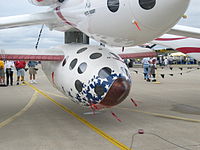- Scaled Composites White Knight
-
White Knight White Knight carrying SpaceShipOne Role Carrier aircraft National origin United States Manufacturer Scaled Composites First flight August 1, 2002 Number built 1 Developed from Scaled Composites Proteus Variants Scaled Composites White Knight Two The Scaled Composites Model 318 White Knight is a jet-powered carrier aircraft used to launch the Scaled Composites SpaceShipOne experimental spacecraft. It was developed by Scaled Composites as part of their Tier One program. The aircraft is subsequently being offered by Scaled on a contract basis as a research testbed, and was also used for drop tests of the Boeing X-37 spaceplane from June 2005 until April 2006.
Contents
Design and development
The Scaled Composites model number for White Knight is 318. White Knight is registered with the Federal Aviation Administration as N318SL.[citation needed]
The White Knight carrier airplane was designed around the twin afterburning J-85 engines, which were selected for their availability and low cost. The aircraft was a completely new independent design. White Knight and SpaceShip One shared the same forward fuselage outer mold line (OML) to reduce development costs and with the original intent to allow for White Knight to act as a flying simulator for training SpaceShip One pilots White Knight first flew on August 1, 2002. The flight was aborted shortly after takeoff due to a problem with the outboard wing spoilers. These trailing edge spoilers were designed to greatly increase the glide slope so that the White Knight vehicle could act as a flying simulator for training of SpaceShip One pilots. During the first flight, the mechanical over-center torque was insufficient to maintain the spoilers in the closed position. The spoilers deployed into the free stream and began a limit cycle forcing the pilot (Mike Melvill) to abort. The spoilers were subsequently disabled completely and the desire for a steep glide slope matching SpaceShip One was abandoned.
White Knight next flew on August 5, 2002, and this time performed well. Development proceeded over the next few months. With White Knight developed and evaluated, on April 18, 2003 White Knight and SpaceShipOne were presented to the media.
Subsequently, White Knight flew as part of the Tier One program that won the Ansari X Prize on 2004 October 4. Afterwards White Knight was used to carry and launch DARPA's experimental X-37 spaceplane for its approach and landing tests in 2005 and 2006.
It was followed up by the White Knight 2 which has a similar but larger design.
SpaceShipOne program
Flights of White Knight are numbered, starting with flight 1 on August 1, 2002. Flights where SpaceShipOne was carried also get one or two appended letters. An appended "C" indicates that the flight was a captive carry, and "L" indicates that SpaceShipOne was launched. If the flight actually flown differs in category from the intended flight then two letters are appended, the first giving the intended mission and the second the mission actually performed.
White Knight flights carrying SpaceShipOne[citation needed] Flight Date SS1 Pilot SpaceShipOne flight 24C May 20, 2003 Peter Siebold 01C 29C July 29, 2003 Brian Binnie 02C 30L August 7, 2003 Brian Binnie 03G 31LC August 27, 2003 Brian Binnie 04GC 32L August 27, 2003 Brian Binnie 05G 37L September 23, 2003 Peter Siebold 06G 38L October 17, 2003 Peter Siebold 07G 40L November 14, 2003 Brian Binnie 08G 41L November 19, 2003 Brian Binnie 09G 42L December 4, 2003 Peter Siebold 10G 43L December 17, 2003 Peter Siebold 11P 49L March 11, 2004 Brian Binnie 12G 53L April 8, 2004 Brian Binnie 13P 56L May 13, 2004 Brian Binnie 14P 60L June 21, 2004 Mike Melvill 15P 65L September 29, 2004 Mike Melvill 16P 66L October 4, 2004 Brian Binnie 17P X-37 test program
White Knight was contracted to perform both captive carry and drop test flights of the DARPA/Boeing X-37. First captive carry flight was on June 21, 2005, and first drop was on April 7, 2006 (the X-37 was subsequently damaged on landing at Edwards AFB). Initially, the flights originated from Mojave, but following the landing incident, the program was moved to Air Force Plant 42 in Palmdale, California, and at least five subsequent flights were made there.
Adaptive Compliant Wing test program
In late 2006, White Knight flew a seven-flight test program of the Adaptive Compliant Wing developed by FlexSys Inc with funding by the Air Force Research Laboratory. A laminar flow test article was mounted vertically under White Knight's centerline pylon for the 20-flight-hour research program that tested the flexible wing's aerodynamic characteristics.[1][2]
Specifications
Data from Scaled Composites[3]
General characteristics
- Crew: 2
- Capacity: 2
- Payload: 8,000 lb (3,600 kg)
- Length: ()
- Wingspan: 82 ft (25 m)
- Height: ()
- Powerplant: 2 × General Electric J85-GE-5 afterburning turbojets
- Fuel capacity: 6,400 lb (2,900 kg)
Performance
- Service ceiling: 53,000 ft plus (16,000 m)
See also
References
- ^ Scott, William B, "Morphing Wings", Aviation Week & Space Technology, 2006-11-27
- ^ Scott, William B, "White Knight Back in Action", Aviation Week & Space Technology, 2006-11-27
- ^ http://www.scaled.com/projects/tierone/data_sheets/html/white_knight.htm
External links
- Scaled Composites' Tier One website
- White Knight's FAA registration
- WhiteKnight to launch X-37 test flights
Lists relating to aviation General Aircraft (manufacturers) · Aircraft engines (manufacturers) · Airlines (defunct) · Airports · Civil authorities · Museums · Registration prefixes · Rotorcraft (manufacturers) · TimelineMilitary Accidents/incidents Records The Spaceship Company Companies 
People Ships SpaceShipOne · White Knight · SpaceShipTwo · (Enterprise · Voyager) · White Knight Two · (Eve) · SpaceShipThree
Sequence Places See also Scaled Composites Main designs VariEze • Long-EZ • Boomerang • Pond Racer • Proteus • SpaceShipOne • SpaceShipTwo • White Knight • White Knight Two • Tier One • Tier 1b • Tier Two
Technology demonstrators Unmanned vehicles As subcontrator Categories:- Individual aircraft
- Scaled Composites
- Tier One
- United States experimental aircraft 2000–2009
- Twin boom aircraft
- Aviation stubs
Wikimedia Foundation. 2010.




